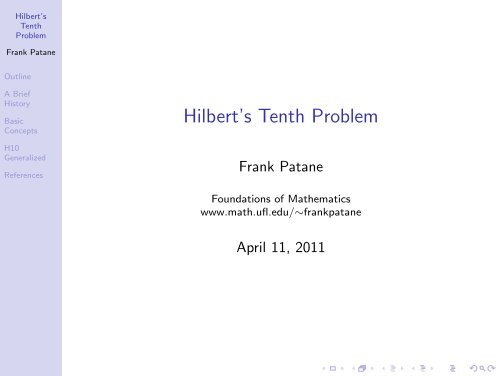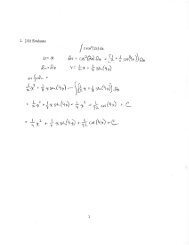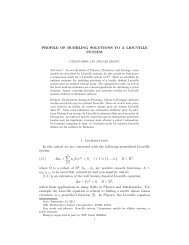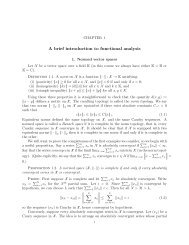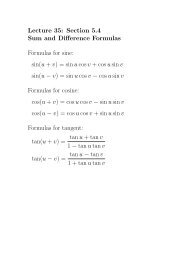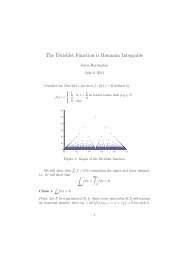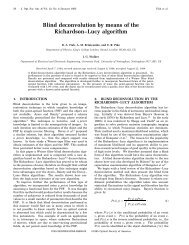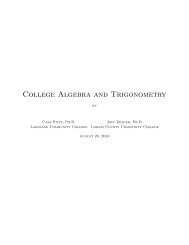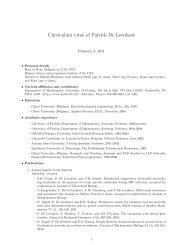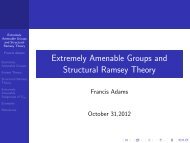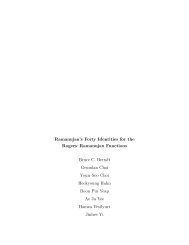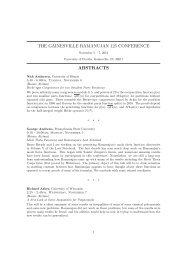Hilbert's Tenth Problem
Hilbert's Tenth Problem
Hilbert's Tenth Problem
Create successful ePaper yourself
Turn your PDF publications into a flip-book with our unique Google optimized e-Paper software.
Hilbert’s<br />
<strong>Tenth</strong><br />
<strong>Problem</strong><br />
Frank Patane<br />
Outline<br />
A Brief<br />
History<br />
Basic<br />
Concepts<br />
H10<br />
Generalized<br />
References<br />
Hilbert’s <strong>Tenth</strong> <strong>Problem</strong><br />
Frank Patane<br />
Foundations of Mathematics<br />
www.math.ufl.edu/∼frankpatane<br />
April 11, 2011
Hilbert’s<br />
<strong>Tenth</strong><br />
<strong>Problem</strong><br />
Frank Patane<br />
Outline<br />
A Brief<br />
History<br />
Basic<br />
Concepts<br />
H10<br />
Generalized<br />
References<br />
1 A Brief History<br />
2 Basic Concepts<br />
3 H10 Generalized<br />
4 References
Hilbert’s<br />
<strong>Tenth</strong><br />
<strong>Problem</strong><br />
Frank Patane<br />
Outline<br />
A Brief<br />
History<br />
Basic<br />
Concepts<br />
H10<br />
Generalized<br />
References<br />
A Brief History<br />
In 1900, at the International Congress of mathematicians,<br />
David Hilbert presented a list of problems that was to guide the<br />
mathematics community for the coming century.
Hilbert’s<br />
<strong>Tenth</strong><br />
<strong>Problem</strong><br />
Frank Patane<br />
Outline<br />
A Brief<br />
History<br />
Basic<br />
Concepts<br />
H10<br />
Generalized<br />
References<br />
A Brief History<br />
In 1900, at the International Congress of mathematicians,<br />
David Hilbert presented a list of problems that was to guide the<br />
mathematics community for the coming century.
Hilbert’s<br />
<strong>Tenth</strong><br />
<strong>Problem</strong><br />
Frank Patane<br />
Outline<br />
A Brief<br />
History<br />
Basic<br />
Concepts<br />
H10<br />
Generalized<br />
References<br />
A Brief History<br />
The tenth problem on Hilbert’s list of 23 problems states:
Hilbert’s<br />
<strong>Tenth</strong><br />
<strong>Problem</strong><br />
Frank Patane<br />
Outline<br />
A Brief<br />
History<br />
Basic<br />
Concepts<br />
H10<br />
Generalized<br />
References<br />
A Brief History<br />
The tenth problem on Hilbert’s list of 23 problems states:<br />
”Find an algorithm to determine whether a given polynomial<br />
Diophantine equation with integer coefficients has an integer<br />
solution.”
Hilbert’s<br />
<strong>Tenth</strong><br />
<strong>Problem</strong><br />
Frank Patane<br />
Outline<br />
A Brief<br />
History<br />
Basic<br />
Concepts<br />
H10<br />
Generalized<br />
References<br />
A Brief History<br />
The tenth problem on Hilbert’s list of 23 problems states:<br />
”Find an algorithm to determine whether a given polynomial<br />
Diophantine equation with integer coefficients has an integer<br />
solution.”<br />
In 1970 Matijasevic proves that no such algorithm can exist<br />
using the work of Davis-Putnam-Robinson.
Hilbert’s<br />
<strong>Tenth</strong><br />
<strong>Problem</strong><br />
Frank Patane<br />
Outline<br />
A Brief<br />
History<br />
Basic<br />
Concepts<br />
H10<br />
Generalized<br />
References<br />
Basic Concepts<br />
More generally one could ask for an algorithm for solving a<br />
system of diophantine equations.
Hilbert’s<br />
<strong>Tenth</strong><br />
<strong>Problem</strong><br />
Frank Patane<br />
Outline<br />
A Brief<br />
History<br />
Basic<br />
Concepts<br />
H10<br />
Generalized<br />
References<br />
Basic Concepts<br />
More generally one could ask for an algorithm for solving a<br />
system of diophantine equations.<br />
Noting that f1 = f2 = . . . = fn = 0 iff f 2<br />
1 + f 2<br />
2 + . . . f 2<br />
n = 0 we<br />
see that finding an algorithm for solving a system of<br />
diophantine equations is equivalent to Hilbet’s tenth problem.
Hilbert’s<br />
<strong>Tenth</strong><br />
<strong>Problem</strong><br />
Frank Patane<br />
Outline<br />
A Brief<br />
History<br />
Basic<br />
Concepts<br />
H10<br />
Generalized<br />
References<br />
Basic Concepts<br />
More generally one could ask for an algorithm for solving a<br />
system of diophantine equations.<br />
Noting that f1 = f2 = . . . = fn = 0 iff f 2<br />
1 + f 2<br />
2 + . . . f 2<br />
n = 0 we<br />
see that finding an algorithm for solving a system of<br />
diophantine equations is equivalent to Hilbet’s tenth problem.<br />
As an exercise, show that if there is no algorithhm for finding<br />
whether a diophantine equation has positive solutions, then<br />
Hilbert’s tenth problem is proved in the negative. As a hint,<br />
think of Lagrange four squares theorem.
Hilbert’s<br />
<strong>Tenth</strong><br />
<strong>Problem</strong><br />
Frank Patane<br />
Outline<br />
A Brief<br />
History<br />
Basic<br />
Concepts<br />
H10<br />
Generalized<br />
References<br />
Basic Definitions<br />
Definition: A ⊂ N k is called a Diophantine set if there exists<br />
a polynomial p ∈ Z[y1, . . . , yk, x1, . . . , xm] such that<br />
(a1, . . . , ak) ∈ A iff there exists x1, . . . , xm ∈ N such that<br />
p(a1, . . . , ak, x1, . . . , xm) = 0.
Hilbert’s<br />
<strong>Tenth</strong><br />
<strong>Problem</strong><br />
Frank Patane<br />
Outline<br />
A Brief<br />
History<br />
Basic<br />
Concepts<br />
H10<br />
Generalized<br />
References<br />
Basic Definitions<br />
Definition: A ⊂ N k is called a Diophantine set if there exists<br />
a polynomial p ∈ Z[y1, . . . , yk, x1, . . . , xm] such that<br />
(a1, . . . , ak) ∈ A iff there exists x1, . . . , xm ∈ N such that<br />
p(a1, . . . , ak, x1, . . . , xm) = 0.<br />
We will call the elements of a diophantine set the parameters<br />
of the polynomial.
Hilbert’s<br />
<strong>Tenth</strong><br />
<strong>Problem</strong><br />
Frank Patane<br />
Outline<br />
A Brief<br />
History<br />
Basic<br />
Concepts<br />
H10<br />
Generalized<br />
References<br />
Basic Definitions<br />
Definition: A ⊂ N k is called a Diophantine set if there exists<br />
a polynomial p ∈ Z[y1, . . . , yk, x1, . . . , xm] such that<br />
(a1, . . . , ak) ∈ A iff there exists x1, . . . , xm ∈ N such that<br />
p(a1, . . . , ak, x1, . . . , xm) = 0.<br />
We will call the elements of a diophantine set the parameters<br />
of the polynomial.<br />
So considering the Pellian equation x 2 − d(y + 1) 2 = 1 over N<br />
we know that this equation will be solvable exactly when d is 0<br />
or not a perfect square.
Hilbert’s<br />
<strong>Tenth</strong><br />
<strong>Problem</strong><br />
Frank Patane<br />
Outline<br />
A Brief<br />
History<br />
Basic<br />
Concepts<br />
H10<br />
Generalized<br />
References<br />
Basic Definitions<br />
Definition: A ⊂ N k is called a Diophantine set if there exists<br />
a polynomial p ∈ Z[y1, . . . , yk, x1, . . . , xm] such that<br />
(a1, . . . , ak) ∈ A iff there exists x1, . . . , xm ∈ N such that<br />
p(a1, . . . , ak, x1, . . . , xm) = 0.<br />
We will call the elements of a diophantine set the parameters<br />
of the polynomial.<br />
So considering the Pellian equation x 2 − d(y + 1) 2 = 1 over N<br />
we know that this equation will be solvable exactly when d is 0<br />
or not a perfect square.<br />
Thus the set of natural numbers that include 0 and all<br />
non-square integers is a Diophantine set.
Hilbert’s<br />
<strong>Tenth</strong><br />
<strong>Problem</strong><br />
Frank Patane<br />
Outline<br />
A Brief<br />
History<br />
Basic<br />
Concepts<br />
H10<br />
Generalized<br />
References<br />
Basic Definitions<br />
Definition: A ⊂ N k is called a Diophantine set if there exists<br />
a polynomial p ∈ Z[y1, . . . , yk, x1, . . . , xm] such that<br />
(a1, . . . , ak) ∈ A iff there exists x1, . . . , xm ∈ N such that<br />
p(a1, . . . , ak, x1, . . . , xm) = 0.<br />
We will call the elements of a diophantine set the parameters<br />
of the polynomial.<br />
So considering the Pellian equation x 2 − d(y + 1) 2 = 1 over N<br />
we know that this equation will be solvable exactly when d is 0<br />
or not a perfect square.<br />
Thus the set of natural numbers that include 0 and all<br />
non-square integers is a Diophantine set.<br />
Can anyone think of another Diophantine set?
Hilbert’s<br />
<strong>Tenth</strong><br />
<strong>Problem</strong><br />
Frank Patane<br />
Outline<br />
A Brief<br />
History<br />
Basic<br />
Concepts<br />
H10<br />
Generalized<br />
References<br />
Basic Definitions<br />
Definition: A ⊂ N is recursively enumerable if there is a<br />
Turing machine such that A is the set that it prints out if left<br />
running forever. (This is from Definition 5.21 in the class<br />
notes.)
Hilbert’s<br />
<strong>Tenth</strong><br />
<strong>Problem</strong><br />
Frank Patane<br />
Outline<br />
A Brief<br />
History<br />
Basic<br />
Concepts<br />
H10<br />
Generalized<br />
References<br />
Basic Definitions<br />
Definition: A ⊂ N is recursively enumerable if there is a<br />
Turing machine such that A is the set that it prints out if left<br />
running forever. (This is from Definition 5.21 in the class<br />
notes.)<br />
Definition: A ⊂ N is recursive if there is an algorithm which<br />
terminates after a finite amount of time and correctly<br />
determines whether or not a given integer is in A or not.<br />
(Again Defintion 5.21)
Hilbert’s<br />
<strong>Tenth</strong><br />
<strong>Problem</strong><br />
Frank Patane<br />
Outline<br />
A Brief<br />
History<br />
Basic<br />
Concepts<br />
H10<br />
Generalized<br />
References<br />
Basic Definitions<br />
Definition: A ⊂ N is recursively enumerable if there is a<br />
Turing machine such that A is the set that it prints out if left<br />
running forever. (This is from Definition 5.21 in the class<br />
notes.)<br />
Definition: A ⊂ N is recursive if there is an algorithm which<br />
terminates after a finite amount of time and correctly<br />
determines whether or not a given integer is in A or not.<br />
(Again Defintion 5.21)<br />
Is a Diophantine set necessarily recurisively enumerable?
Hilbert’s<br />
<strong>Tenth</strong><br />
<strong>Problem</strong><br />
Frank Patane<br />
Outline<br />
A Brief<br />
History<br />
Basic<br />
Concepts<br />
H10<br />
Generalized<br />
References<br />
Basic Definitions<br />
Definition: A ⊂ N is recursively enumerable if there is a<br />
Turing machine such that A is the set that it prints out if left<br />
running forever. (This is from Definition 5.21 in the class<br />
notes.)<br />
Definition: A ⊂ N is recursive if there is an algorithm which<br />
terminates after a finite amount of time and correctly<br />
determines whether or not a given integer is in A or not.<br />
(Again Defintion 5.21)<br />
Is a Diophantine set necessarily recurisively enumerable?<br />
Yes! Take a Diophantine equation f (a, x1, . . . , xk) = 0, and<br />
make an algorithm that tries all possible values of a, x1, . . . , xk<br />
and prints a whenever f (a, x1, . . . , xk) = 0.
Hilbert’s<br />
<strong>Tenth</strong><br />
<strong>Problem</strong><br />
Frank Patane<br />
Outline<br />
A Brief<br />
History<br />
Basic<br />
Concepts<br />
H10<br />
Generalized<br />
References<br />
Any recursive set is recursively enumerable.<br />
Observations
Hilbert’s<br />
<strong>Tenth</strong><br />
<strong>Problem</strong><br />
Frank Patane<br />
Outline<br />
A Brief<br />
History<br />
Basic<br />
Concepts<br />
H10<br />
Generalized<br />
References<br />
Any recursive set is recursively enumerable.<br />
Observations<br />
However there exists recursively enumerable sets that are not<br />
recursive.
Hilbert’s<br />
<strong>Tenth</strong><br />
<strong>Problem</strong><br />
Frank Patane<br />
Outline<br />
A Brief<br />
History<br />
Basic<br />
Concepts<br />
H10<br />
Generalized<br />
References<br />
Any recursive set is recursively enumerable.<br />
Observations<br />
However there exists recursively enumerable sets that are not<br />
recursive.<br />
Yet is it true that any recursively enumerable set is<br />
Diophantine?
Hilbert’s<br />
<strong>Tenth</strong><br />
<strong>Problem</strong><br />
Frank Patane<br />
Outline<br />
A Brief<br />
History<br />
Basic<br />
Concepts<br />
H10<br />
Generalized<br />
References<br />
Any recursive set is recursively enumerable.<br />
Observations<br />
However there exists recursively enumerable sets that are not<br />
recursive.<br />
Yet is it true that any recursively enumerable set is<br />
Diophantine?<br />
Yes! Matiyasevich’s Theorem is that a set of integers is<br />
Diophantine if an only if it is recursively enumerable.
Hilbert’s<br />
<strong>Tenth</strong><br />
<strong>Problem</strong><br />
Frank Patane<br />
Outline<br />
A Brief<br />
History<br />
Basic<br />
Concepts<br />
H10<br />
Generalized<br />
References<br />
Any recursive set is recursively enumerable.<br />
Observations<br />
However there exists recursively enumerable sets that are not<br />
recursive.<br />
Yet is it true that any recursively enumerable set is<br />
Diophantine?<br />
Yes! Matiyasevich’s Theorem is that a set of integers is<br />
Diophantine if an only if it is recursively enumerable.<br />
But how exactly does this prove Hilbert’s tenth problem?
Hilbert’s<br />
<strong>Tenth</strong><br />
<strong>Problem</strong><br />
Frank Patane<br />
Outline<br />
A Brief<br />
History<br />
Basic<br />
Concepts<br />
H10<br />
Generalized<br />
References<br />
H10 as a Corollary<br />
Fact 1: Some recursively enumerable sets are not<br />
recursive.(1930s)
Hilbert’s<br />
<strong>Tenth</strong><br />
<strong>Problem</strong><br />
Frank Patane<br />
Outline<br />
A Brief<br />
History<br />
Basic<br />
Concepts<br />
H10<br />
Generalized<br />
References<br />
H10 as a Corollary<br />
Fact 1: Some recursively enumerable sets are not<br />
recursive.(1930s)<br />
Fact 2: Matiyasevich’s Theorem states that all recursively<br />
enumerable sets are Diophantine sets.(1970)
Hilbert’s<br />
<strong>Tenth</strong><br />
<strong>Problem</strong><br />
Frank Patane<br />
Outline<br />
A Brief<br />
History<br />
Basic<br />
Concepts<br />
H10<br />
Generalized<br />
References<br />
H10 as a Corollary<br />
Fact 1: Some recursively enumerable sets are not<br />
recursive.(1930s)<br />
Fact 2: Matiyasevich’s Theorem states that all recursively<br />
enumerable sets are Diophantine sets.(1970)<br />
Conclusion: There exist some Diophantine sets that are not<br />
recursive.
Hilbert’s<br />
<strong>Tenth</strong><br />
<strong>Problem</strong><br />
Frank Patane<br />
Outline<br />
A Brief<br />
History<br />
Basic<br />
Concepts<br />
H10<br />
Generalized<br />
References<br />
H10 as a Corollary<br />
Fact 1: Some recursively enumerable sets are not<br />
recursive.(1930s)<br />
Fact 2: Matiyasevich’s Theorem states that all recursively<br />
enumerable sets are Diophantine sets.(1970)<br />
Conclusion: There exist some Diophantine sets that are not<br />
recursive.<br />
In other words, there is a Diophantine equation depending on a<br />
parameter for which no algorithm can decide for which values<br />
of the parameter the equation has a solution.
Hilbert’s<br />
<strong>Tenth</strong><br />
<strong>Problem</strong><br />
Frank Patane<br />
Outline<br />
A Brief<br />
History<br />
Basic<br />
Concepts<br />
H10<br />
Generalized<br />
References<br />
H10 Generalized<br />
We can generalize H10 to other integral domains.
Hilbert’s<br />
<strong>Tenth</strong><br />
<strong>Problem</strong><br />
Frank Patane<br />
Outline<br />
A Brief<br />
History<br />
Basic<br />
Concepts<br />
H10<br />
Generalized<br />
References<br />
H10 Generalized<br />
We can generalize H10 to other integral domains.<br />
Let R be and integral domain. Then H10 over R is the<br />
question,
Hilbert’s<br />
<strong>Tenth</strong><br />
<strong>Problem</strong><br />
Frank Patane<br />
Outline<br />
A Brief<br />
History<br />
Basic<br />
Concepts<br />
H10<br />
Generalized<br />
References<br />
H10 Generalized<br />
We can generalize H10 to other integral domains.<br />
Let R be and integral domain. Then H10 over R is the<br />
question,<br />
Is there an algorithm with<br />
input: f (x1, x2, . . . , xn) ∈ R[x1, . . . , xn]<br />
output: Yes or no, according to whether the there exists<br />
a1, . . . , an ∈ R such that f (a1, a2, . . . , an) = 0.
Hilbert’s<br />
<strong>Tenth</strong><br />
<strong>Problem</strong><br />
Frank Patane<br />
Outline<br />
A Brief<br />
History<br />
Basic<br />
Concepts<br />
H10<br />
Generalized<br />
References<br />
H10 Generalized<br />
Doing a bit of research we find that H10 over R = C, R, Qp<br />
has been solved in the positive by using ”elimination theory.”[5]
Hilbert’s<br />
<strong>Tenth</strong><br />
<strong>Problem</strong><br />
Frank Patane<br />
Outline<br />
A Brief<br />
History<br />
Basic<br />
Concepts<br />
H10<br />
Generalized<br />
References<br />
H10 Generalized<br />
Doing a bit of research we find that H10 over R = C, R, Qp<br />
has been solved in the positive by using ”elimination theory.”[5]<br />
However the above mentioned R are all fields. A closer<br />
situation of H10 as originally stated might take R to be just a<br />
unique factorization domain or maybe even a Dedeking domain.
Hilbert’s<br />
<strong>Tenth</strong><br />
<strong>Problem</strong><br />
Frank Patane<br />
Outline<br />
A Brief<br />
History<br />
Basic<br />
Concepts<br />
H10<br />
Generalized<br />
References<br />
H10 Generalized<br />
Doing a bit of research we find that H10 over R = C, R, Qp<br />
has been solved in the positive by using ”elimination theory.”[5]<br />
However the above mentioned R are all fields. A closer<br />
situation of H10 as originally stated might take R to be just a<br />
unique factorization domain or maybe even a Dedeking domain.<br />
The obvious generalization is to take a number field K and set<br />
R equal to the ring of integers of K.
Hilbert’s<br />
<strong>Tenth</strong><br />
<strong>Problem</strong><br />
Frank Patane<br />
Outline<br />
A Brief<br />
History<br />
Basic<br />
Concepts<br />
H10<br />
Generalized<br />
References<br />
H10 Generalized<br />
Doing a bit of research we find that H10 over R = C, R, Qp<br />
has been solved in the positive by using ”elimination theory.”[5]<br />
However the above mentioned R are all fields. A closer<br />
situation of H10 as originally stated might take R to be just a<br />
unique factorization domain or maybe even a Dedeking domain.<br />
The obvious generalization is to take a number field K and set<br />
R equal to the ring of integers of K.<br />
So we could have R being the Gaussian integers or Eisenstein<br />
integers, for instance.
Hilbert’s<br />
<strong>Tenth</strong><br />
<strong>Problem</strong><br />
Frank Patane<br />
Outline<br />
A Brief<br />
History<br />
Basic<br />
Concepts<br />
H10<br />
Generalized<br />
References<br />
H10 Generalized<br />
Doing a bit of research we find that H10 over R = C, R, Qp<br />
has been solved in the positive by using ”elimination theory.”[5]<br />
However the above mentioned R are all fields. A closer<br />
situation of H10 as originally stated might take R to be just a<br />
unique factorization domain or maybe even a Dedeking domain.<br />
The obvious generalization is to take a number field K and set<br />
R equal to the ring of integers of K.<br />
So we could have R being the Gaussian integers or Eisenstein<br />
integers, for instance.<br />
Conjecture: H10 has a negative answer for the ring of integers<br />
for any number field.
Hilbert’s<br />
<strong>Tenth</strong><br />
<strong>Problem</strong><br />
Frank Patane<br />
Outline<br />
A Brief<br />
History<br />
Basic<br />
Concepts<br />
H10<br />
Generalized<br />
References<br />
You’ve Got <strong>Problem</strong>s!<br />
1.) Let A, B be Diophantine sets. Show that A ∪ B and A ∩ B<br />
are Diophantine sets. Is the complement of A necessarily<br />
Diophantine?
Hilbert’s<br />
<strong>Tenth</strong><br />
<strong>Problem</strong><br />
Frank Patane<br />
Outline<br />
A Brief<br />
History<br />
Basic<br />
Concepts<br />
H10<br />
Generalized<br />
References<br />
You’ve Got <strong>Problem</strong>s!<br />
1.) Let A, B be Diophantine sets. Show that A ∪ B and A ∩ B<br />
are Diophantine sets. Is the complement of A necessarily<br />
Diophantine?<br />
2.) Find a Diophantine equation that has no non-negative<br />
integer solutions, yet has infinitely many integer solution. Why<br />
does this not contradict the ”exercise” mentioned on slide 5?
Hilbert’s<br />
<strong>Tenth</strong><br />
<strong>Problem</strong><br />
Frank Patane<br />
Outline<br />
A Brief<br />
History<br />
Basic<br />
Concepts<br />
H10<br />
Generalized<br />
References<br />
You’ve Got <strong>Problem</strong>s!<br />
1.) Let A, B be Diophantine sets. Show that A ∪ B and A ∩ B<br />
are Diophantine sets. Is the complement of A necessarily<br />
Diophantine?<br />
2.) Find a Diophantine equation that has no non-negative<br />
integer solutions, yet has infinitely many integer solution. Why<br />
does this not contradict the ”exercise” mentioned on slide 5?<br />
3.) Complete the claim that x 2 − d(y + 1) 2 = 1 is solvable in<br />
N iff d = 0 or d is not a perfect square.
Hilbert’s<br />
<strong>Tenth</strong><br />
<strong>Problem</strong><br />
Frank Patane<br />
Outline<br />
A Brief<br />
History<br />
Basic<br />
Concepts<br />
H10<br />
Generalized<br />
References<br />
References<br />
Thank you, and I hope you are inspired to look into H10!
Hilbert’s<br />
<strong>Tenth</strong><br />
<strong>Problem</strong><br />
Frank Patane<br />
Outline<br />
A Brief<br />
History<br />
Basic<br />
Concepts<br />
H10<br />
Generalized<br />
References<br />
References<br />
Thank you, and I hope you are inspired to look into H10!<br />
References:<br />
[1.] Shlapentokh, A. Hilbert’s <strong>Tenth</strong> <strong>Problem</strong>: Diophantine<br />
Classes and Extensions to Global Fields.Cambridge University<br />
Press, 2007.<br />
[2.]Matijasevich, U. Hilbert’s <strong>Tenth</strong> <strong>Problem</strong>. MIT Press,<br />
1993.<br />
[3.]Sussmann, H J. Hilbert’s <strong>Tenth</strong> <strong>Problem</strong>. 1971<br />
[4.]Rogers, H. Theory of Recursive Functions and Effective<br />
Computability. MIT Press, 1987.<br />
[5.] Poonen, Bjorn. Hilbert’s <strong>Tenth</strong> <strong>Problem</strong>. MSRI<br />
Introductory Workshop on Rational and Integral Points on<br />
Higher-dimensional Varieties 2006


